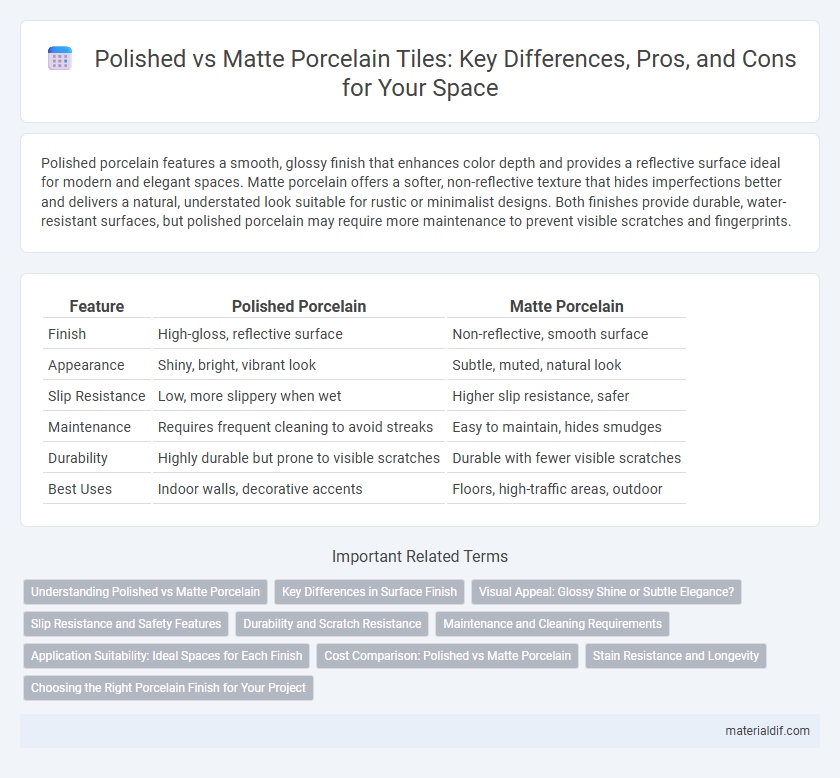Polished porcelain features a smooth, glossy finish that enhances color depth and provides a reflective surface ideal for modern and elegant spaces. Matte porcelain offers a softer, non-reflective texture that hides imperfections better and delivers a natural, understated look suitable for rustic or minimalist designs. Both finishes provide durable, water-resistant surfaces, but polished porcelain may require more maintenance to prevent visible scratches and fingerprints.
Table of Comparison
| Feature | Polished Porcelain | Matte Porcelain |
|---|---|---|
| Finish | High-gloss, reflective surface | Non-reflective, smooth surface |
| Appearance | Shiny, bright, vibrant look | Subtle, muted, natural look |
| Slip Resistance | Low, more slippery when wet | Higher slip resistance, safer |
| Maintenance | Requires frequent cleaning to avoid streaks | Easy to maintain, hides smudges |
| Durability | Highly durable but prone to visible scratches | Durable with fewer visible scratches |
| Best Uses | Indoor walls, decorative accents | Floors, high-traffic areas, outdoor |
Understanding Polished vs Matte Porcelain
Polished porcelain offers a glossy, reflective finish that enhances color depth and mimics natural stone, making it ideal for elegant, high-traffic areas requiring easy cleaning. Matte porcelain provides a non-reflective, textured surface with superior slip resistance and a more understated, natural appearance suitable for bathrooms and outdoor spaces. Choosing between polished and matte porcelain depends on desired aesthetics, maintenance preferences, and safety considerations.
Key Differences in Surface Finish
Polished porcelain features a glossy, reflective surface achieved through a mechanical polishing process, enhancing brightness and making the tiles appear more vibrant and smooth. Matte porcelain, on the other hand, has a non-reflective, textured finish that provides a natural, understated look with better slip resistance and less visible dirt or smudges. These key differences in surface finish impact the aesthetic appeal, maintenance requirements, and suitability for various environments like bathrooms, kitchens, or high-traffic areas.
Visual Appeal: Glossy Shine or Subtle Elegance?
Polished porcelain tiles offer a glossy shine that enhances color depth and reflects light, creating a vibrant, modern look ideal for spaces seeking brightness and sophistication. Matte porcelain tiles provide a subtle elegance with a soft, muted finish that minimizes glare and hides smudges, making them perfect for rustic, contemporary, or minimalist designs. The choice between polished and matte porcelain hinges on desired visual impact, with polished emphasizing luminosity and matte focusing on understated texture.
Slip Resistance and Safety Features
Polished porcelain tiles offer a sleek, reflective surface but generally have lower slip resistance, making them less ideal for areas prone to moisture or heavy foot traffic. Matte porcelain tiles feature a textured finish that enhances grip, significantly improving slip resistance and safety in residential and commercial environments. Selecting matte porcelain is recommended for bathrooms, kitchens, and outdoor spaces where minimizing slip hazards is crucial.
Durability and Scratch Resistance
Polished porcelain features a glossy finish that enhances scratch resistance by creating a harder surface, making it ideal for high-traffic areas and surfaces prone to abrasion. Matte porcelain, with its textured finish, offers strong durability but can be more susceptible to visible scratches and wear over time. Both types are crafted from dense, vitrified clay, ensuring excellent structural strength, but polished porcelain tends to maintain its appearance longer under heavy use.
Maintenance and Cleaning Requirements
Polished porcelain surfaces exhibit a glossy finish that requires regular cleaning with non-abrasive products to maintain their shine and prevent scratching. Matte porcelain, with its textured finish, hides dirt and smudges more effectively, reducing the frequency of cleaning and making it more slip-resistant and ideal for high-traffic areas. Both finishes demand routine maintenance, but polished porcelain needs more careful handling to avoid damage, while matte porcelain tolerates harsher cleaning methods without losing its appearance.
Application Suitability: Ideal Spaces for Each Finish
Polished porcelain tiles offer a glossy, reflective surface that enhances light in spaces like living rooms, bathrooms, and kitchens, making them ideal for modern, high-traffic areas where a sleek appearance is desired. Matte porcelain tiles provide a non-slip, subdued finish suitable for outdoor patios, commercial spaces, and entryways, offering durability and safety without sacrificing style. Selecting between polished and matte porcelain depends on the balance between aesthetic preference and functional requirements specific to the intended space.
Cost Comparison: Polished vs Matte Porcelain
Polished porcelain tiles typically cost 10-20% more than matte porcelain due to the additional labor and finishing processes involved in achieving the glossy surface. Matte porcelain is generally more affordable and offers a non-slip texture, making it a cost-effective choice for high-traffic or wet areas. When budgeting for porcelain tiles, consider that polished options may increase upfront costs but can enhance aesthetic value and light reflection in spaces.
Stain Resistance and Longevity
Polished porcelain offers superior stain resistance due to its glossy, non-porous surface that repels liquids and prevents dirt accumulation, making it ideal for high-traffic areas. Matte porcelain, while aesthetically appealing with its natural, textured finish, tends to absorb stains more easily and may require more maintenance to preserve its appearance. Both finishes provide excellent longevity, but polished porcelain generally maintains its pristine look longer under heavy use, enhancing durability in residential and commercial spaces.
Choosing the Right Porcelain Finish for Your Project
Polished porcelain offers a glossy, reflective surface ideal for enhancing light and creating a sleek, modern aesthetic, while matte porcelain provides a non-slip, understated finish suited for high-traffic or outdoor areas. Selecting the right porcelain finish depends on factors like desired visual impact, maintenance requirements, and safety considerations, with polished surfaces requiring more frequent cleaning to maintain shine and matte finishes offering better durability against scratches. For projects emphasizing elegance and brightness, polished porcelain is optimal, whereas matte porcelain suits functional spaces demanding grip and low maintenance.
Polished Porcelain vs Matte Porcelain Infographic

 materialdif.com
materialdif.com